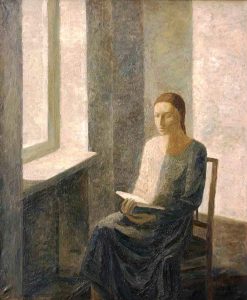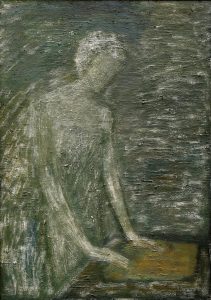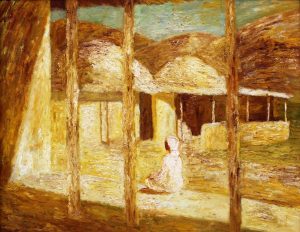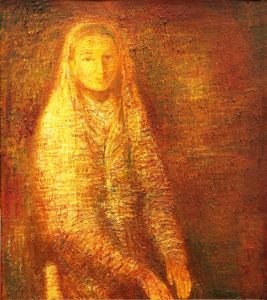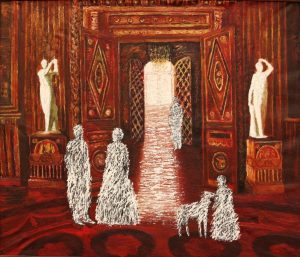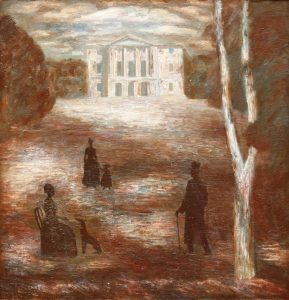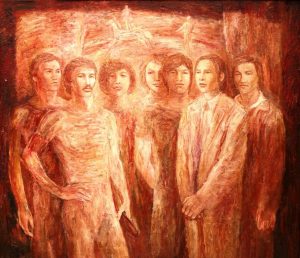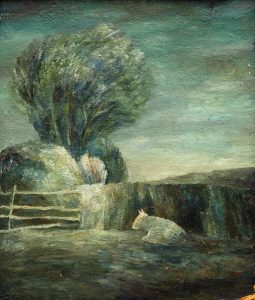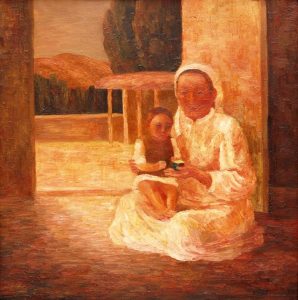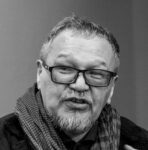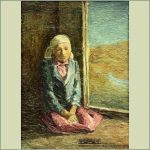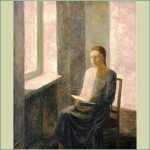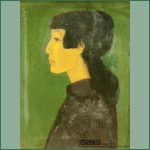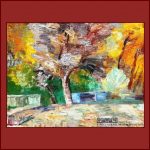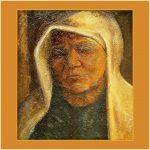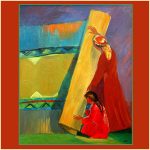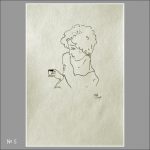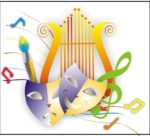We continue to introduce you to the works by Kyrgyz artists in the collection of the Museum of Fine Arts named after G.Aitiev. Art historian GAMAL BOKONBAYEV this time presents MURAT BEKDZHANOV‘s works.
Some of the works are presented on the museum’s website, the rest are in the collection, but are not presented on the museum’s website. There are only 18 works in the review, conditionally they can be divided by genre: landscapes – 5, portraits – 12, no still lives, one thematic composition.
In part one there are 9 works.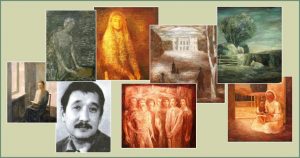
MURAT BEKDZHANOV (born 1946) is a Poster artist. The painter. Honored Worker of Culture of the Kyrgyz Republic. He was born on November 17, 1946 in Tokmak. In 1966, he graduated from the Frunze Art College, in 1972 – the graphic faculty of the Moscow Art Institute named after V.I. Surikov, the poster workshop of N. Ponomarev. Since 1976, he has been a member of the Union of Artists of the USSR. The works are in the Kyrgyz National Museum of Fine Arts named after G. Aitiev, as well as museums in the CIS (Information from the website of the museum named after G. Aitiev)
A girl illuminated by the sun. 1974. Oil on canvas, 121×100
A girl is sitting near the window, holding a book on her lap, reading. These are poems, serious poems. Not a tabloid novel or a monograph. We see it clearly! We see restrained colors, the logic of tones, strict lines, antique beauty. The monotonous verticals and horizontals of room axonometry are enlivened by an inclined line – this is the sun in the window, which has become square, illuminated the girl diagonally. The border of light and shadow runs in the middle, and the girl is included in a rectangular roll call with the third dimension. The tonal accent – the dazzling page – enhances the tilt and… the drama. Radiators are usually placed under the windowsill, but the artist removed them: they fell out of his harmony. The artist wrote picturesque poems: about life, creativity, a girl, and removed all non-ethical. But for some reason I left a blinding page. There is an admonition to this remark from above: “For the Soviet modernist, there is the concept of accent, but there is no disharmony. There is a concept of contrast: one page in the light, the other in the shadow. That’s right.” But it will be difficult to read, my eyes will hurt, it will be uncomfortable, you are our serene ones! Disharmony turns out! But nothing seems to bother the girl, and she divinely pacifies me: “Don’t worry, the page is on fire – this is about Brodsky* leaving and Vysotsky* not being published… these times will soon pass. Everything will be fine. Manuscripts don’t burn – Art lasts forever.”
*Brodsky Josef – a Russian and American poet and essayist
**Vysotsky Vladimir – Russian poet, singer and actor (AD notes)
Morning. Oil on canvas, 70×50,5, 1998
Earlier in the morning, the sky lightened slightly and objects are already distinguishable. They are drawn in shades of gray, contours and texture. A woman is in the kitchen, about to cook breakfast, her hands on the table in front of the chopping board. Young, slender, strong, with beautiful hands, with short hair, in a simple dress. The heat comes from the board. Or is it a small tablecloth? Or a pie? Just out of the oven? Just an accent? That’s how the morning starts! With daily bread! From the warm kitchen. She holds her hands as if she is rolling out dough, but the rolling pin is not visible. The face is not visible in the dark. It seems that the woman has wings behind her back; a square on the wall darkens; a single eye appears higher in the center. The visions of the night recede before dawn. It’s kind of mystical. Unexpected and inappropriate. Why do you want to live here? In such a simple environment, with a woman without a face. I want to live! Something is holding. It holds something that doesn’t exist and never will. The charm of utopia! A social and artistic utopia! In the absence of a real future, real prospects, the only refuge is painting… the 90s are over. It seemed that everything Soviet was gone, the project was over and would never happen again. But nothing has changed for the artist, everything is as before: minimalism, style, subtle taste. The conviction that it is necessary to draw not reality, but to establish a new world. A modern, social world of equality and simple beauty. New approval projects! Like El Lissitzky’s*! PRUNES**! Nothing is gone! The ideals of Soviet modernism continue! Ideals that few people understand now. So it’s time to do new work.
Russian Russian painter, graphic artist, designer, author of architectural projects, teacher; one of the greatest masters of the Russian avant-garde. *El Lisitsky (real name Lisitsky Lazar Markovich, 1890-1941), is a Russian painter, graphic artist, designer, author of architectural projects, teacher.
**Prouns – The main elements of architectonic forms (mass, weight, materiality, proportions, rhythm, space, etc.) were worked out by L.Lisitsky on a plane in graphic experiments — “Prouns” (projects for establishing a new one).
A more detailed introduction to El Lisitsky and the prouns is here https://www.livemaster.ru/topic/297383-el-lisitskij-hudozhnik-po-prizvaniyu-revolyutsioner-po-ubezhdeniyu (AD’s notes)
Midday. Oil on canvas, 70×89,5, 1996
View of the courtyard from the outdoor veranda. Residential and outbuildings are visible; canopies are supported by wooden columns; on the roofs are piles of hay, similar to domes. In shape, they echo the distant hills – light against a dark background. At noon, the sun is mercilessly scorching from the south side. The whole yard is flooded with white-light yellow light, and brown shadows glow from reflexes. The artist continues his favorite theme – the modernized environment. Simplicity, style, logic. The verticals of the columns divided the space into rectangles. The shadow of the canopy is a triangular wedge. The base of the courtyard is also a triangle extending beyond the lower edge of the painting. The hemispheres pressed down on the rectangular base… A woman is sitting on the edge of the veranda. What made her sit in the sun? Decided to get warm? Judging by the posture, this is a young woman, they don’t warm up, they burn from the inside. A woman in dazzling white is the formal designation of the center of the composition. The center of the enclosed courtyard. She was put here on eternal duty by a strong-willed decision. It serves as an accent in modernist composition. And in order to create an idea, the artist masterfully burned the color. It’s too bright, too hot, too dangerous, like in a frenzied fantasy of a madman. A formal find turned into a pictorial idea! The idea of a challenge! This is a subconscious challenge to the heat and the courtyard. A woman does not want to live with a wordless accent in the quintessence of southern isolation – she wants to become the sun! It’s better to burn without seeing a way out. It looks like suicide. Or she’ll just have a sunstroke.
* The most important thing, the main thing, the true essence of something is L. (AD’s notes)
Portrait of Rahimа. Oil on canvas, 90×80, 1996
The famous art critic Olga Popova writes about the artist’s works as follows: “Bekdzhanov’s portraits are executed in an exquisite range of a few colors that are close to subtle tonal designs. Most often, these are mood portraits, in which the emotional state characteristic of a particular person is conveyed.” End of quote… This is the bride. Of course, the bride. A girl before an important event. Smiling, hoping for happiness and love. The charm of trustfulness and the beauty of hope! All-conquering meekness! In a thick chapan, in a white dress (only the collar is visible); a white scarf on his head. He is sitting in a submissive position: his hands are folded in his lap. Only the edge of the seat peeks out. The sun shone on the face and figure, but the bride’s hands! They are in the shade, but they seem to radiate heat themselves… It seems that all brides are the same and “there is nothing special about her”, but the artist sees a fantastic color – the light comes from the sun, and the heat comes from the human soul… It looks like “The Girl in the Green Scarf” from 1976, but there is activity and dynamics. And here there is static and peace. We shun peace and quiet. These words have become synonymous with stagnation and boredom for us. And we do not understand that peace saves strength… What awaits her? The author does not give any hints, no details, there is a void around, a brutal, coarse-grained texture. And this is the answer to the question – an uncomfortable environment awaits the bride! Prickly questions seem to come from the brown depths: “Does he know the customs? Will he show the skill? Will the household be able to handle it? Will she be able to please her mother-in-law?”… And only faith in people will help her overcome bias, wariness, pride and prejudice*.
*”Pride and Prejudice” is the title of the famous novel by the English writer Jane Austen, written in 1813, it describes the way of life and customs of English society at that time (AD’s notes )
Interior. Oil on canvas, 119.5×140, 1989
The interior of the late nineteenth century. The Art Nouveau style is richly decorated; the enfilade spaces are decorated with antique sculptures. The doors open into perspective and let light into the inner rooms. Gaudy, tasteless, provincial. The decor, especially the diamonds, is the author’s arbitrariness. The Soviet man has everything mixed up: a noble’s nest with a cherry orchard, and ten little Negroes who are being chased by the Baskervilles’ dog… A love triangle: husband, wife, and a third extra. Or maybe it’s just a servant waiting? Then it gets really boring. A child is playing with a hunting dog. The interior is full of details, and the characters are silhouettes woven with whimsical laces of light. The contrast between the static of the interior and the dynamics of vibrating dashes. An interesting combination… But in 1989, something else is relevant! In the USSR, “perestroika”, and in Kyrgyzstan – “New Wave”! Both Satar Aitiyev and Dzhambul Dzhumabayev have become prominent in the new trends. But the Soviet modernist does not want to get involved with pictorial innovations; he understands that something needs to be changed and feels that everything will be a stretch. It used to be easier – there was no freedom, and the machine operator went into design, book illustration, and theater. The time has come when everything is possible, and it turned out that nothing is possible for talent. Nothing will work, except for the black. The paradigm of Soviet Kyrgyz pictorial modernism is disappearing. The other one doesn’t. Honest artists don’t get another one quickly. And you still have to do something. And what? It’s unclear! The state of uncertainty in anticipation of an era of change… Perhaps this is the set design of a particular performance, then all of the above does not count. That’s how one word changes perception!
Silhouettes. Oil on canvas, 130×124.5, 1988
There is a tree in the foreground, then a lawn, a manor house behind the lawn, a portico with columns, and then the eternal sky with cumulus clouds … Russian expanses! The exterior is painted with light and air, and the characters… are cut out of black paper. They are flat and only promising abbreviations allow us to understand who is closer and who is further away. There are unfading values – the sky, trees, lawn, architecture, finally! And the mirage people come and go… The escape of the machine operator to the set design. Got it! It is difficult to give out new meanings and new forms all the time. I want to relax, relax and easily operate with theatrical patterns. It’s not working! Back in the middle of a scandal! Why would an original artist, with his unique and long-suffering theme, need this far-fetched scene from another time, from another country, from another culture? Why would he do that? Yes! Russian Russian language became like a “native language” and Russian culture, like a common, Soviet one. Anyone has the right to plunge into the space of global contexts. Into the literary world of Turgenev, Tolstoy, Chekhov. The world of the noble nest. A lady with a dog is sitting on a chair: her health has been shaken after the loss of her husband. And suddenly “He” appears! A family friend. There is a child in the distance, a daughter playing with a babysitter. He depicted a passing culture. He showed her how she would leave. Over time, becoming a lifeless template, then a silhouette, and finally turning into a mirage! And only the eternal sky will remain… World culture will forever “put pressure” on us, and from a metaphysical point of view it does not matter whether it is Russian or English. The ability of the people to develop spirituality in any conditions is important. And they will never be favorable. And it’s hard to explain to politicians – it’s easier to draw.
The youth of Kyrgyzstan. Circus performers. Oil on canvas, 119,1×139, 1987
In 1962, the first circus troupe “Young Kyrgyzstan” was organized in the Republic. The head is Evgeny Alexandrovich Zhang Funlin (Dzhanybekov); participants are Mamytbekov Esengul, A. Zhusupov, S. Beishebaev, B. Kulubaev, S. Sooronbaev, M. Zhumaliev, Clara Lynchan. They entered the arena for the first time on October 20, 1963! This day is considered the birthday of the Kyrgyz circus! The numbers of the program were created on the basis of national games, some fragments of performances were accompanied by playing on the komuz… It seems to me that the painting depicts the participants of this very first troupe, a sample of 1962! Evgeny Dzhanybekov stands out on the right; in a suit, in a tie, leaning slightly on a cane. There is a girl in the center; the blind collar of the dress, the hairstyle – all this points to Clara Lynchan. The one on the far right looks like a clown: smiling, wearing a baggy jacket. Maybe it’s Sooronbayev, the first Kyrgyz clown… Or maybe not. These are all my assumptions. I don’t have reliable data, we don’t even know everyone by name. And I don’t have time for detailed research either, I’m not a historian – I’m more interested in artistic paradoxes… They stand, as a selection, slender, beautiful, strong! Athletes and acrobats. They are standing behind the “scenes” in full combat readiness, the curtain is pulled back, the circus arena, the equestrian room, the rider are visible. Faces glow with lines, the space is sculpted by texture, monochrome is rich in shades. That’s just the picture looks more like… a street poster painted in oil on canvas, only the text is missing. That’s what they did! Toulouse-Lautrec did, in the USSR they did, in 20 years! Is the avant-garde coming back? It doesn’t look like it. The new form does not add new content. This is a special case. It was cool to make a poster and sell it to a museum as an easel painting! It was freedom! Artistic freedom! They could say that the artist had cheated. They didn’t say. There was a common understanding – it was appropriate, original and talented! The liberal-minded environment defended the artist’s right to experiment. Not all searches were successful! In this case, it worked! It turned out famously, like circus riders. And behind the ease of execution, there is a skill gained over the years, like that of circus workers. So what if the author applied the street art format? It helped to capture the “outgoing nature” and preserve the spontaneity! And looking like a poster is not a vice! This is a virtue! All posters should be like this – elegant, aesthetic! And the easel painting should be treated lightly, as a folk pastime, and not as a responsible assignment of the party and the government! We need to be closer to people! In general, the 25th anniversary of the first circus troupe in Kyrgyzstan was celebrated cheerfully!
Twilight. Cardboard, oil, 68,7×58,7, 1982
The rural yard is fenced with a hedge, a cow lies under it. A haystack and bushes crowd behind the hedge; a tree rises, hills are visible in the distance and above all this is the eternal sky. Grisaille in green and blue shades. It looks like a moonlit night. But the author clearly defined the time of day in the title – twilight. The earth is illuminated not by the moon, but by the sky. Where is the extra light coming from? Judging by the haystack – on the right, and judging by the cow – on the left. Do the objects themselves glow? It doesn’t look like it. Usually light emits heat, but there are not enough warm shades here. The light source is located somewhere in front of the painting, it snatches out some of the objects, but cannot be depicted! Something otherworldly? … Judging by the haystack and lush greenery, it’s late summer or early autumn. It’s a warm season, and the painting is cold. Why?.. A cow, a tree, a fence are eternal symbols! Recognizable and… different. There are no familiar sensations, and we cannot believe that they are not in the picture. There is no tenderness for the old, there is no joy from meeting the beautiful, there is no pastoral pathos! Frozen traditions! And modernization will not help, neither technical nor artistic! Stop dreaming! The urban artist took off the positive blinders and saw the modern village in a completely different way. Before us is the twilight of a rural idyll, when all feelings cool down in anticipation of the night…
Colored cubes. Oil on canvas, 80×80, 1982
A woman in a white dress with a baby on her lap is sitting in a room with an open door. The child is wearing a white shirt and a brown sleeveless jacket. It’s quiet outside and mom is not afraid of drafts, let the little one feel the coolness… Beautiful rural landscape: sky, mountains, summer dense greenery, a duval, a canopy, a perfectly clean yard. Ochre is light, ochre is red, dark green shades. Harmony of color! Joy for the eyes! And the viewer’s eye revolves around a tiny yellow-red-green cube! A poisonous accent looks like a dissonance! The center of the composition is a product of the modern chemical industry! But how carefully mom holds the toy in the palm of her hand. How interesting is the baby! The cube is relevant! Erne Rubik invented the Rubik’s Cube, a puzzle toy, in 1974, in 1981 it appeared in the USSR. And maybe mom and child are playing Rubik’s cube!.. Global visual innovations are being aggressively introduced into nature, into the natural environment of the Kyrgyz village, and … this is inevitable. Tradition is under the pressure of modernization! But the author asks a more complicated riddle. In his understanding, tradition is something very peculiar, unlike the generally accepted and familiar. His tradition is a dry style, simplified shapes and restrained colors, and it is the bright cube that looks alive and natural in the picture. And the viewer does not understand: between what and what is the dispute going on here? Or maybe this is a confrontation of the ideal rural modernity with the real urban postmodernity? Postmodernism** offered a new paradigm*** and helped to come to terms with the eclecticism of the 80s. And what will help us now? What are we going to do about today’s visual lawlessness?
* Art Nouveau is a style of fine, decorative, applied, jewelry, interior art and architecture. It originated at the end of the 19th century and was popular until the outbreak of the First World War. This style is distinguished by an abundance of decorative details and elements, smooth lines, rounded and flowing shapes. It is also characterized by a variety of floral ornaments and natural motifs. In each country, it was called differently: in Russia – “modern”, in Austria – “secession”, in the USA — “Tiffany”, in France — “Art Nouveau”, in Germany — “Art Nouveau”, in Belgium – “style of twenty”, in England — “modern styleIn Italy — the “liberty style”, and in Switzerland — the “spruce style”.
** Postmodernism is a broad movement that developed in the mid-late 20th century in philosophy, art, architecture and criticism and marked a departure from modernism.
*** A paradigm is a model (of anything, but most often this word is used in application to science or a general worldview), a generally recognized model or example of how to approach solving problems in this area at this stage of development. (AD’s notes )
Telegram-channel in Kyrgyz & Russian:
Санжарбек Данияровдун коомдук фонду
Фонд Санжарбека Даниярова
Subscribe if interested




